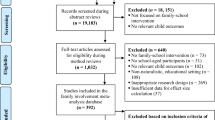Abstract
The emerging information age will make education/work relationships stronger and stronger. These relationships must be emphasized by school counselors. This document discusses how this can be done both for youth planning to attend a four-year college and for those planning some other kind of postsecondary career-oriented education. One possible solution is suggested.
Similar content being viewed by others
References
BLS. (1995). Slide 39-Education pays. Washington, D.C.: Bureau of Labor Statistics.
Cosca, Theresa. (1994-95). High-earning workers who don't have a bachelor's degree. Occupational Outlook Quarterly, 38(4), pp. 26-46.
Drucker, P. E. (November, 1994). The age of social transformation. The Atlantic Monthly, 274, pp. 53-80.
Educational attainment in the United States: March 1993 and 1992. (March, 1993). Table 9-earnings by educational attainment for persons 18 years old and older. Washington, D.C.: U.S. Department of Commerce, Bureau of the Census, pp. 58-67.
Geraghty, Mary. (July 19, 1996). More students quitting college before sophomore year, data show. Chronicle of Higher Education, 45, pp. 35-36.
Hecker, Daniel. (1996). Earnings and major field of study of college graduates. Occupational Outlook Quarterly, 40(2), pp. 10-21.
Marshall, R. & Tucker, M. (1992). Thinking for a living. New York: Basic Books.
National Center on Education and the Economy. (1990). America's choice: High skills or low wages. Rochester, NY: Author.
National Center for Education Statistics. (1995). Table 1-Educational attainment of 1980 high school sophomores by 1992. High School and Beyond: Sophomore Cohort, 1980-1992. Washington, D.C.: U.S. Department of Education.
National Center for Education Statistics. (1996). Table 15-Average number of months 1989-90 beginning post-secondary students were enrolled through first degree (if any) or last enrollment as of Spring, 1994. Source: U.S. Department of Education, National Center for Education Statistics, 1990 Beginning Postsecondary Students Longitudinal Study-Second Follow-up (BPS:90/94).
National Center for Education Statistics (1996) Table 8-Percentage distribution of 1989-90 beginning postsecondary students according to persistence and attainment of highest degree as of Spring, 1994, by degree working toward at first institution and level of first institution attended. Source: U.S. Department of Education, National Center for Education Statistics. 1990 Beginning Postsecondary Students Longitudinal Study-Second follow-up (BPS:90/94).
OCChart. (1995). Education: it pays for the rest of your life. Occupational Outlook Quarterly 39(1), p. 52.
OCChart. (1995-1996). Occupations that require at least an associate's degree are growing the fastest, but they will not provide the most jobs. Occupational Outlook Quarterly, 39(4), p. 48.
OCChart. (1996). Earnings of recent college graduates: The class of 1993. Occupational Outlook Quarterly 40(3), p. 44.
OCChart. (1997-1998). Projected change in employment, 1996-2006. Occupational Outlook Quarterly, 41(4), p. 11.
Olson, L. (1996). The career game. Education Week, 16(5), pp. 31-33.
Shelley, Kristina. (1996). 1994-2005-Lots of college-level jobs-but not for all graduates. Occupational Outlook Quarterly, 40(2), pp. 2-9.
U.S. Department of Labor. (1991). What work requires of schools: A SCANS report for America 2000. Washington, D.C.: Author.
U.S. Department of Labor. (April, 1996). College enrollment and work activity of 1995 high school graduates. USDL. Washington, D.C.: Author, pp. 96-152.
Wash, Darrel P. (1995-96). A new way to classify occupations by education and training. Occupational Outlook Quarterly, 39(4), pp. 28-40.
Author information
Authors and Affiliations
About this article
Cite this article
Hoyt, K.B., Maxey, J. Career Counseling in the Information Age. Journal of Career Development 28, 129–138 (2001). https://doi.org/10.1023/A:1012542810927
Issue Date:
DOI: https://doi.org/10.1023/A:1012542810927




